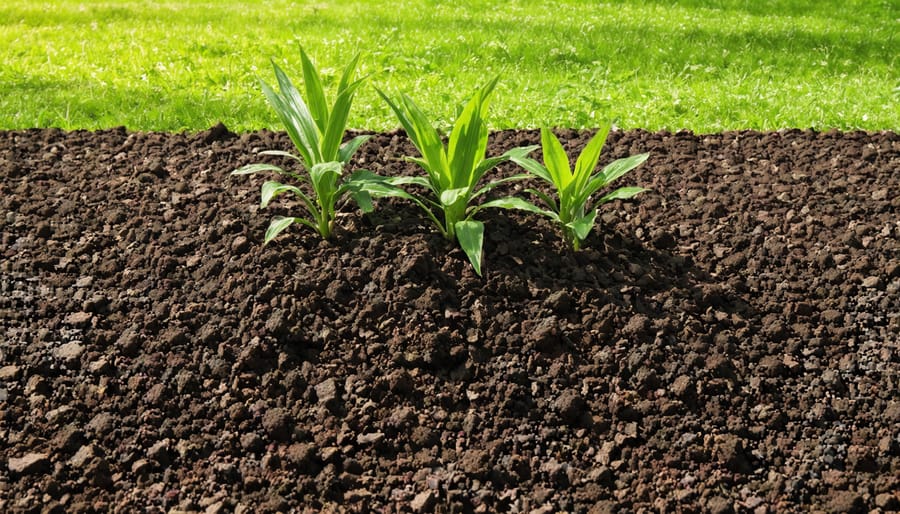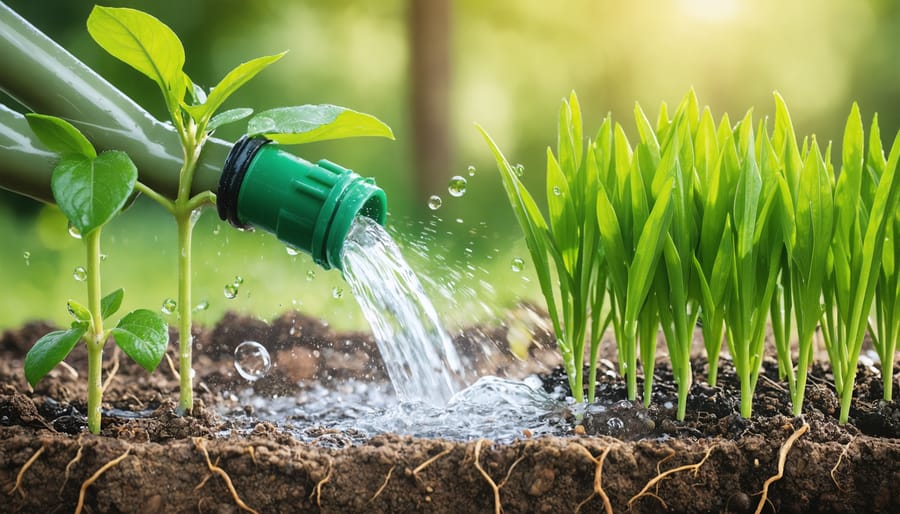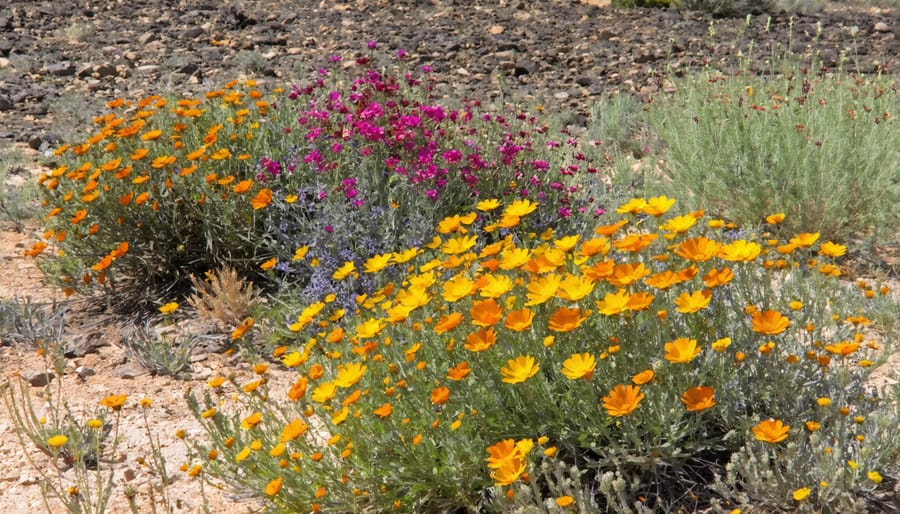Plant native species adapted to your local climate to reduce water consumption and maintenance needs. Choose permeable pavers, gravel, or mulch for hardscaping to allow rainwater absorption and prevent runoff. Install a drip irrigation system or use soaker hoses to efficiently deliver water directly to plant roots. Incorporate eco-smart landscaping techniques like rainwater harvesting, composting, and xeriscaping to create a low-impact, sustainable outdoor environment.
Sustainable Landscaping Materials
Recycled Mulch and Compost
Using recycled mulch and compost in your landscaping offers a wealth of benefits for both your plants and the planet. Recycled mulch, often made from repurposed wood chips or shredded bark, helps retain soil moisture, regulate soil temperature, and suppress weed growth. As it decomposes, it enriches the soil with essential nutrients. Compost, derived from organic waste like food scraps and yard clippings, is a nutrient-rich soil amendment that improves soil structure, promotes healthy root development, and boosts beneficial microbial activity. By opting for recycled mulch and compost, you not only nurture your garden but also divert valuable organic materials from landfills, reducing waste and supporting a circular economy. These eco-friendly landscaping solutions are cost-effective, sustainable alternatives to synthetic fertilizers and virgin mulch products. Embrace the power of recycled mulch and compost to cultivate a thriving, Earth-friendly outdoor oasis while minimizing your environmental impact.

Permeable Pavers
Permeable pavers are an eco-friendly solution for your outdoor spaces, allowing water to seep through the gaps between pavers and into the soil below. Unlike traditional concrete or asphalt surfaces, permeable pavers prevent water runoff by absorbing rainfall and reducing the strain on storm drains. This helps to maintain the natural water cycle, recharge groundwater, and minimize the risk of flooding. Permeable pavers come in a variety of materials, such as concrete, brick, and natural stone, offering both environmental benefits and aesthetic appeal. By choosing permeable pavers for your patio, driveway, or walkways, you can create a beautiful and functional outdoor space while promoting water conservation and reducing your environmental impact. With proper installation and maintenance, permeable pavers are a durable and long-lasting solution that contributes to the overall sustainability of your landscaping.
Water-Saving Irrigation Methods

Drip Irrigation Systems
Drip irrigation systems offer a smart, eco-friendly solution for watering your garden. These systems deliver water directly to the roots of your plants through a network of tubes and emitters, minimizing evaporation and runoff. By precisely controlling the amount and location of water delivery, drip irrigation can reduce water usage by up to 70% compared to traditional sprinklers. This targeted approach not only conserves water but also promotes healthier plant growth by maintaining consistent soil moisture levels. Installing a drip irrigation system is a simple DIY project that can save you time and money while contributing to a greener, more sustainable outdoor environment. With the ability to customize the layout based on your garden’s specific needs, drip irrigation is a versatile choice for any landscape. Embrace the efficiency and environmental benefits of drip irrigation and enjoy a thriving, water-wise garden.
Smart Sprinkler Controllers
Smart sprinkler controllers take the guesswork out of watering your lawn and garden. These innovative devices adjust irrigation schedules based on real-time weather data and soil moisture levels, ensuring your plants receive the optimal amount of water. By connecting to local weather stations or accessing online forecasts, smart controllers can automatically skip watering during rainy periods or increase irrigation during dry spells. Some advanced models even feature soil sensors that measure moisture content at the root level, allowing for precise watering that adapts to your plants’ specific needs. This not only conserves water but also promotes healthier plant growth by preventing over- or under-watering. With smart sprinkler controllers, you can save time, money, and precious resources while maintaining a lush, vibrant outdoor space. Embrace this eco-friendly technology and enjoy the convenience of a beautifully watered landscape without the hassle of manual adjustments.
Eco-Friendly Outdoor Lighting
Solar-Powered Path Lights
Solar-powered path lights offer an eco-friendly and convenient way to illuminate your walkways and outdoor spaces. These ingenious lights harness the sun’s energy during the day and automatically turn on at dusk, providing a soft, inviting glow. Installation is a breeze, as there’s no wiring required – simply stake them along your path, and let the sun do the rest. Not only do solar path lights add ambiance and safety to your outdoor areas, but they also reduce your energy consumption and electricity bills. With a variety of styles available, from classic lanterns to modern bollards, you can find the perfect look to complement your landscaping. Opting for solar path lights is a small but impactful way to make your outdoor spaces more environmentally friendly and inviting.
Dark Sky-Compliant Fixtures
Dark sky-compliant fixtures are a crucial component of eco-friendly landscaping. These specially designed outdoor lights minimize light pollution by directing illumination downward, where it’s needed, rather than upward into the night sky. This not only reduces wasted energy but also protects wildlife and preserves the beauty of the starry sky. When selecting fixtures, look for the International Dark Sky Association (IDA) seal of approval, which ensures the light meets stringent standards. Consider warm-toned LEDs with a color temperature of 3000K or lower to minimize blue light emissions. Shielded wall sconces, hooded path lights, and fully-shielded spotlights are all excellent options. By incorporating dark sky-compliant lighting into your outdoor space, you’ll create a more environmentally responsible and visually appealing nighttime atmosphere.
Native and Drought-Tolerant Plants
Benefits of Native Plants
Native plants are an eco-friendly choice for your outdoor space. Adapted to thrive in your region’s climate and soil conditions, they require less water, fertilizer, and maintenance compared to non-native species. By conserving resources, you can save both time and money while creating a beautiful, sustainable landscape. Native plants also provide essential habitat and food sources for local wildlife, including birds, butterflies, and beneficial insects. As these creatures visit your garden, they help maintain a healthy ecosystem through pollination and natural pest control. Choosing native plants not only enhances your outdoor experience but also supports biodiversity and contributes to the well-being of your local environment. Embrace the beauty and resilience of native species and create a harmonious oasis that both you and the wildlife can enjoy.
Drought-Tolerant Landscaping
When selecting plants for a drought-tolerant landscape, opt for native species that have adapted to thrive in your region’s climate. Succulents like sedum and agave store water in their fleshy leaves, while hardy herbs such as lavender, rosemary, and sage offer fragrant foliage without demanding frequent watering. Ornamental grasses like blue fescue and fountain grass provide textural interest and graceful movement with minimal upkeep. Incorporate ground covers like creeping thyme or ice plant to fill spaces between pavers and suppress weeds. Xeriscaping, a landscaping technique focused on water conservation, emphasizes grouping plants with similar water needs together and using mulch to retain soil moisture. By embracing drought-tolerant plants and water-wise design principles, you can create an outdoor oasis that’s both beautiful and sustainable, even in the face of dry spells and water restrictions.

Conclusion
Making your outdoor space more environmentally friendly is a rewarding endeavor that benefits both your home and the planet. By incorporating sustainable landscaping materials, water-wise irrigation techniques, energy-efficient lighting, and native plant species, you can create a beautiful and eco-conscious yard that thrives in harmony with nature. Choosing permeable pavers, organic mulch, and recycled materials reduces waste and supports healthy soil. Installing drip irrigation, rain sensors, and smart controllers optimizes water use and minimizes waste. Opting for solar-powered or LED lighting fixtures conserves energy while enhancing your outdoor ambiance. Selecting native plants adapted to your climate promotes biodiversity, reduces maintenance needs, and supports local ecosystems.
As you plan and implement these eco-friendly outdoor solutions, remember that every small change makes a difference. Start with one area of your yard and gradually expand your efforts over time. Engage your family and friends in the process, sharing your knowledge and inspiring others to adopt sustainable practices in their own outdoor spaces. By creating an environmentally conscious yard, you not only contribute to a healthier planet but also cultivate a deeper connection with nature right outside your door. Embrace the opportunity to make a positive impact and enjoy the many benefits of a sustainable, thriving outdoor oasis.